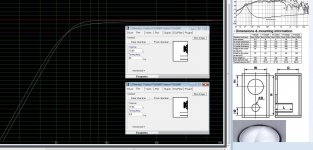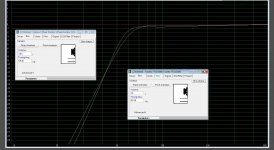I've played mostly with the unshielded RS180 (as seen in newer versions of the big "full range plus helpers" Statement speakers or tiny stuffed port speakers alike) since it plays big low clear LOUD bass, but the RS150's tend to crack where cone meets coil if you try to play loud. Perhaps that is the spot that wants some dampening. I don't know anything other than it might be a clue. Exposed voice coil typically emitting treble is yet another clue.
I hope that helps.
I hope that helps.
Great tip Daniel. From working on the FOSTEX, I found not much help at the coil junction, but they had a dust cap. I'll get in there and extend the doping in the back side down there. I have been running a pair for years, but I don't push them that hard and cross over at about 70.
FYI
Neat! http://www.parts-express.com/pe/showdetl.cfm?partnumber=295-355
Daniel, what size box are you using?
I think I would add thin layer of RTV 118 silicon on the cones.
Neat! http://www.parts-express.com/pe/showdetl.cfm?partnumber=295-355
Daniel, what size box are you using?
I think I would add thin layer of RTV 118 silicon on the cones.
I've played mostly with the unshielded RS180 (as seen in newer versions of the big "full range plus helpers" Statement speakers or tiny stuffed port speakers alike) since it plays big low clear LOUD bass, .
Last edited:
friends don't let friends listen to Mpeg files.
(It's a camcorder's file)
It's a bit sour; sounds like a HUGE speaker though. (have one more trick up my sleeve - CD recorder next)
If you have heard a FX120 - 4".....it sounds about the same.
yes, as well as the F120A - about the same as which, exactly?
I was on a roll with the FX120s there for a while, have one pair never tested yet /-:
The little speakers with the 125wks,,,,,well they sounds like they are going to jump off the stand(s).....
This is only a $25 wood - $25 cork build, btw.
I get more excited about cheap projects (than high dollar) for the challenge I guess.
The little speakers with the 125wks,,,,,well they sounds like they are going to jump off the stand(s).....
This is only a $25 wood - $25 cork build, btw.
I get more excited about cheap projects (than high dollar) for the challenge I guess.
Added doping to the inner edge of the RS150. Moved the resonances down further, but did lower them a bit more. I can see why companies have spent a lot of time to do complex curves in the cone to reduce these issues where these old budget Daytons are a simple cone. On the flip side, I don't think I'm brave enough to start doping a $300 Seas.
In a test box, using my DCX, LR4 @ 3K considering full BSC, this driver is very well behaved and can reach the Vifa D27TG that I have in the box. (current B3 @ 1800 is not cutting it for several reasons)
So all this playing with full range has helped me move back to "real" speakers and improve a multi-way. Of course an LR4 passive with BSC and this high a crossover to be well into the woofers impedance rise is a bit of work not to mention rather costly. Hmmm, I do have a pair of Rotel 951's sitting around, or I could hack into the Denon AVR in that room and actually find a use for the 6 amps in it of which I only use two. DIY just gives too many possibilities that same folks don't have! OK, enough talking about a mulit-way in the full range thread. It IS followup to the FOSTEX doping project. Need to hear Doug's latest boxes.
In a test box, using my DCX, LR4 @ 3K considering full BSC, this driver is very well behaved and can reach the Vifa D27TG that I have in the box. (current B3 @ 1800 is not cutting it for several reasons)
So all this playing with full range has helped me move back to "real" speakers and improve a multi-way. Of course an LR4 passive with BSC and this high a crossover to be well into the woofers impedance rise is a bit of work not to mention rather costly. Hmmm, I do have a pair of Rotel 951's sitting around, or I could hack into the Denon AVR in that room and actually find a use for the 6 amps in it of which I only use two. DIY just gives too many possibilities that same folks don't have! OK, enough talking about a mulit-way in the full range thread. It IS followup to the FOSTEX doping project. Need to hear Doug's latest boxes.
They perform nicely in approximately 1 cubic foot ported, although a stuffed port box can go smaller, down to 0.7 cubic foot.FYI Neat! Dayton Audio RS180-8 7" Reference Woofer 295-355 Daniel, what size box are you using? I think I would add thin layer of RTV 118 silicon on the cones.
The harmonics of the alloy cone is well able to compensate and dash up the drone of a port, sounding very much as if a giant sealed box speaker made of 2" thick wood. Also, these harmonics don't need the assistance of plywood because the alloy cone driver is plenty lively enough with MDF.
The treble peak limits the options, but not much. I think it is just different than but not inferior to a paper woofer.
Option #1
Having them cover as wide a bandwidth as possible will reveal awesome pretty bass and the clearest baritone harmonics but the crossover is more complex or has a harsher/steeper handoff point that is harder to integrate. I teamed mine up with a 2" paper cone driver instead of dome mid + dome tweet. I think it important to have quite similar harmonics from the speaker drivers. Mine was a wideband technique "midtweet" application. I realize this cannot be perfect, but it is rich, level and clear.
or
Option #2
As seen in the http://speakerdesignworks.com/index_page_2.html]Statement Speakers we could use a very low crossover point and then replace the higher pitches with a speaker driver good enough to do that same clear bass and rich baritone harmonics without the crossover difficulty. This lets the RS180's work to mechanical limits without shaking up the higher pitches, such as voice, and so the 3 way design involving a small full range to cover the majority of the audio band, is much more powerful and also far lower distortion than most speakers.
The Statement works, with the same rich tone from the woofer, the full range and the really appropriate electrostatic type tweeter. I like it very much even though a lot that the woofer could do has been replaced by the full range.
silicon
Fumes of silicon can release the glue the holds the speaker together and make it unlikely for new glue to hold. RTV silicon also peels off easily. Permatex, siliconized automotive gasket sealant doesn't seem to be as problematic as RTV silicon. My RS180's are actually used untreated.
speaker size study
They just don't make Steinway's the size of toasters. . .
I was studying to determine the minimum size speaker that could successfully replicate a concert with the tone, the clarity, the rich harmonics, the low bass, and some of the power. I decided that it would be quite like the RS180 in a stuffed port box. And, the answer from the experiment was 0.7 cubic foot would be the minimum practical size (grossly approximate) for a realistic speaker And that expectations of a smaller speaker sounding just like a concert are unrealistic expectations that don't need cash applied.
Speaker size study #2
I got a Pyle 4 ohm 6.5" white plastic woofer teamed up with a 4mh coil and some caps in a 0.5 cubic foot sealed box. Atop this went a paper cone 3" which was a bit more efficient in practice and allowed some treble contouring to boost the airy treble. This speaker was the new winner in the smallest size box yet still a realistic speaker. The efficiency is nowhere close to the RS180 and could not belt out the super low bass loud like the RS180 can do.
Opinion
Whether super low bass can be heard loud or not has to do with an ear and with harmonics, but has nothing to do with the actual fact of the fundamental being replayed at any given SPL since the job can be done with the fundamental absent. The poly cone did not perform well in that respect, but the alloy cone excelled at it.
Guess
Perhaps, some of the more successful full range speaker enclosures that are surely not causing a full range to emit super low fundamentals are, instead, reinforcing the bass harmonics so that the bass seems louder and clearer. It can be done with the speaker driver, but I believe it could be done with enclosure tuning. Perhaps that sort of tuning could either give a non-boomy clear sound or it could compensate and clear up midbass harmonics.
. . . Or, we could add a super fast alloy woofer to a full range driver.
back on topic..............
This was not my idea, but a good one.
"could try a larger woofer in a W box" (this time a woofer without the peak)
E.G. 6.5" driver
The driver should be intended for a BR design, i.e. Qts 3.5 - .4 range.
This is intersting, except the huge dip around 13K; aye, aye, aye - never easy!
Madisound Speaker Store
This was not my idea, but a good one.
"could try a larger woofer in a W box" (this time a woofer without the peak)
E.G. 6.5" driver
The driver should be intended for a BR design, i.e. Qts 3.5 - .4 range.
This is intersting, except the huge dip around 13K; aye, aye, aye - never easy!
Madisound Speaker Store
Last edited:
Thanks but unfortunately then there's this Killer bass 3" speaker. The bass is loud, the rest is useless. and here's some 3" subwoofers with more x-max. We could make a very startling clock radio!
Thanks but unfortunately then there's this Killer bass 3" speaker. The bass is loud, the rest is useless. and here's some 3" subwoofers with more x-max. We could make a very startling clock radio!
15W rms and 85dB sensitivity does not a good candidate for bass speaker make.
I just had this ridiculous idea
you know how modulation distortion can make a low freq signal appear when two neighbouring high frequency signals are amplified?
could this phenomenon be used to create bass from higher frequencies?
This phenomenon will only occur occasionally. The theory is that if you play C + G, you "hear" the C an octave below. Perhaps you could get lucky enough that 2nd order distortion will occur in sufficient amounts to trigger the phenomenon before 3rd order distortion makes the whole thing unlistenable. Of course, by then FM distortion will have completely screwed up everything above the low bass.
However.... Remember another phychoacoustic phenomenon: If you have the harmonic structure, you will "hear" the fundamental. If you are only interested in "hearing" 40Hz, your speaker does not need to go below 80Hz. This is why so many small speakers are reported as having good bass.
Bob
- Status
- This old topic is closed. If you want to reopen this topic, contact a moderator using the "Report Post" button.
- Home
- Loudspeakers
- Full Range
- What's the attraction?

